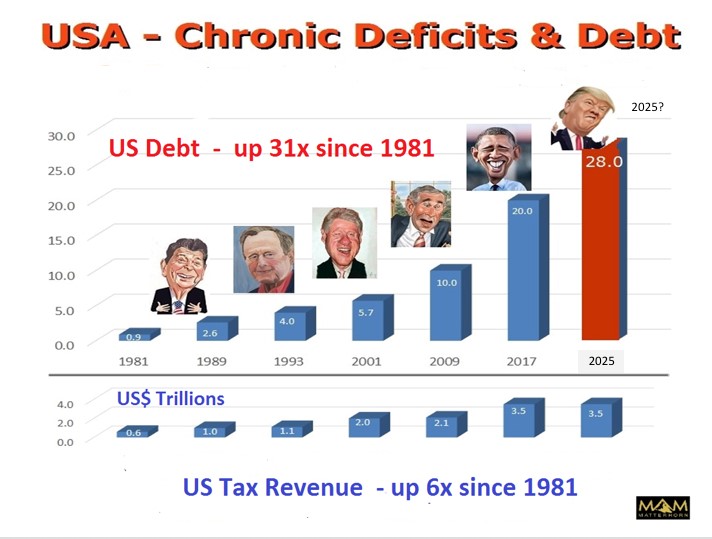Commodity Trade Mantra: Need to hold Physical Gold and Silver as Insurance is Now Greater than ever in History

Article by Egon von Greyerz in Commodity Trade Mantra
In 2019 the investment world will start to realize that asset markets don’t grow to heaven as stocks, bonds and property start their long journey down which will eventually lead to declines of 75% to 95% in real terms. But the major risk is not just investment markets. Just as important is counterparty risk which too few investors are concerned about.
Anyone who wants to protect their wealth should not be invested in any of the bubble asset markets as I have stated in many articles. But to also avoid counterparty risk is a lot harder.
It is clear that it will be extremely hard to navigate investment markets between a rock and a hard place.
FEW INVESTORS WORRY ABOUT COUNTERPARTY RISK
Counterparty risk is the risk associated with the other party to a financial transaction not meeting its obligations.
The average investor never worries about counterparty risk. Because “banks are always safe”. And “government bonds is the safest investment you can buy because governments can never default”.
Investors, both private and institutional are today facing the biggest risk in investment history. And virtually no one is aware of this. The 2007- 9 financial crisis and the fall of Lehman alerted investors to the risk of counterparty failing but since then 10 years have passed and all now seems quiet on the financial risk front.
But things are far from quiet below the calm surface. Because once the next crisis starts, not a single bank could ever repay their depositors and no government can repay their debt with real money.
60 YEARS OF MISMANAGEMENT
Let’s first consider the US government. For 60 years the US federal debt has increased every year, with two minor exceptions in the 1960s. The Clinton surpluses in the 1990s were fake since debt continued to increase in those years. So here we have a government that couldn’t make ends meet for well over half a century. In 1958 when the deficits first started, the US debt was $280 billion. Today it is almost $22 trillion. That is a 75x increase.
Currently the US deficits are running at more than $1 trillion per year and that is very likely to at least double very soon. Since Reagan became President in 1981, US debt has on average doubled every 8 years. Trump inherited a $20 trillion debt and if the trend continues, the US debt will be at least $40 trillion in 2028, whoever is President at that time.

DEBT IS A GLOBAL DISEASE
The US is the most indebted country in the world, but debt is a global disease. In China, total debt has grown from $2 trillion in 2000 to $40 trillion today. Japan is just as bad. Japan with government debt at Yen 1 quadrillion (250% of GDP) would default if rates increased by 0.5%. In Europe, the Mediterranean countries, with Italy the worst, are borrowing heavily, mainly financed by the ECB and German banks. But we only need to look at the balance sheet and share price of Deutsche Bank to realize that the German banking system is on the verge of collapse too. And so it goes on, with most emerging markets heavily indebted and unable to ever repay their debts.
If we then add derivatives at $1.5 quadrillion, we know that global debt and liabilities will implode into a black hole and cause asset prices to collapse.
THERE IS NO SAFE PLACE
Coming back to risk, the few investors who shrewdly exit the overvalued asset markets before they collapse, must then consider what to do with their money.
This is where counterparty risk must be carefully evaluated. Sovereign bonds are clearly a very bad risk since neither capital nor interest, will be paid in the end.
The banking system is a terrible risk. With leverage of 10 to 50 times, banks will be unable to meet their obligations to depositors and clients. Thus, money will first be bailed in and eventually lost as the bank defaults.
If governments try to save the financial system again, it is likely to fail this time. Global debt has doubled since the last financial crisis started in 2006 and printed money will be worth less than the paper it is printed on or the electricity required to create electronic money. So any fresh money fabricated by governments will just debase the currency to ZERO.
The best wealth preservation asset is precious metals. Gold and silver are both a store of value and a medium of exchange. In virtually all periods of crisis in history, precious metals have always been used as money or barter. There is no other asset which provides instant liquidity at a known market price.
Precious metals must obviously be held in physical form and outside the banking system.
ONLY 10% IN GOLD IS NOT SUFFICIENT PROTECTION
Many people ask us what percentage of financial assets to hold in metals. We advised up to 50% back in 2002 when gold was $300. That might be more than many people will be comfortable with. Most of our clients have at least 25% in precious metals. No use holding only 10% when risk is extreme and you expect major problems in the financial system. My recommendation is that investors should at least hold enough gold and silver to fall back on if their other assets should collapse or become illiquid.
As I showed in my article two weeks ago, gold is now as cheap as in 1970 (at $35) and in 2000 (at $250). Thus this is the perfect timing to acquire gold and silver for wealth preservation purposes.
To read this article in Commodity Trade Mantra in its entirety, click here.